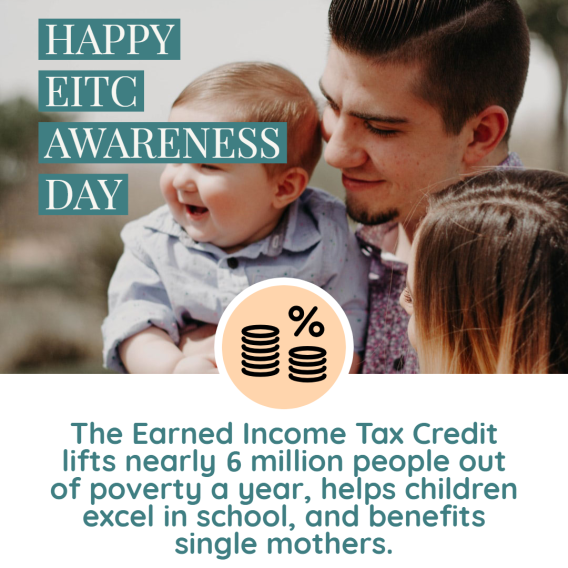By Christine Tran, 2021 Get It Back Campaign Intern
What should organizations know about the new Child Tax Credit?
Nearly every family is eligible to receive the 2021 Child Tax Credit (CTC) to help with the costs of raising kids. This includes families who haven’t filed a tax return and families who don’t have recent income.
Each qualifying household is eligible to receive $3,600 for each child under 6 years old, and $3,000 for each child between 6 and 17 years old. The credit is not a loan.
Advance monthly payments started going out July 15, 2021. Families can receive half of their new credit between July and December 2021 and the remaining half in 2022 when they file a tax return. The CTC expansion can cut the number of children in poverty by more than 40 percent. Learn more about changes to the CTC.
The IRS will send advance payments to families that filed a 2019 or 2020 tax return or used the 2020 IRS Non-Filer Tool to get stimulus checks. While most families will automatically receive monthly advance payments, some will need to sign up by filing a tax return. Many families will be able to use GetCTC.org to get their CTC advance payments.
Why do some families automatically get monthly advance payments and other families don’t?
Families that aren’t required to file taxes (because they have incomes below the minimum filing requirement) or haven’t received stimulus payments for their children, risk missing out on this money which can be used for school clothes and supplies, rent, bills, and nutritious food – to name a few. This group is known as non-filers.
Non-filer families are likely to need additional support signing up for the CTC. They may have questions and concerns about the advance payments and their eligibility. They also may need help using GetCTC.org. Your outreach efforts are critical to help connect non-filer families to the CTC and advance payments.
What barriers do CTC Non-filers face to getting the CTC and advance payments? How can I help?
Here are 7 key challenges that CTC Non-filers may face and how you can leverage your organization’s capacity, time, and resources to help.
1. Lack of technology or Internet access
Challenge: To register for the CTC and advance payments, people must use GetCTC.org, which is only available online via computer or mobile device.
How to Help:
- Set up computers, tablets, or mobile devices in your organization’s office that people can use to access GetCTC.org.
- Hold CTC sign up days using hotspots and laptops/tablets to assist people to use GetCTC.org and to allow those who have personal devices to get connected to the Internet.
- Find out if your local library has computers available for public use. Coordinate with staff and share the address and hours in your CTC messaging.
Helpful Tips:
- Prepare people for what information they need to use GetCTC.org: full legal names and dates of birth for everyone listed on the form; Social Security number (SSN) or Individual Taxpayer Identification Number (ITIN) for themselves and spouse if filing jointly; SSNs for qualifying children; mailing address; and email address. Optional: amount of their first and second stimulus check, bank account and routing numbers for direct deposit, and their 2019 Adjusted Gross Income if they filed a 2019 tax return.
- Have people available to troubleshoot issues that people may have as they use GetCTC.org.
- Print out this Child Tax Credit FAQs for staff and people to refer to if they have questions about the CTC.
- Read this guide by Code for America to learn how to navigate through GetCTC.org and determine the right next steps for families. (Click here for all of Code for America’s navigator resources).
2. No email address
Challenge: People can use a phone number or email address to use GetCTC.org. If people don’t have a phone, they will need an email address to use GetCTC.org.
How to Help:
- Assist people with creating a free email address with a service like Gmail, Yahoo! Mail, or AOL.
Helpful Tips:
- Yahoo! Mail and AOL requires a cell phone number to create an email address. If people don’t have a phone number, they can use Gmail or ProtonMail (choose the free plan).
3. No permanent address
Challenge: When filling out GetCTC.org, people will be required to provide a home address.
How to Help:
- Reassure people that they can still receive monthly advance payments even if they don’t have a home address. This is especially important for people experiencing homelessness. People can arrange to use a trusted address where they want to receive their advance payments or list on the form if they have direct deposit. For example, they can ask a family member, a friend, or a social service provider.
- Let people know that advance payments can also be delivered to P.O. boxes.
- Offer your organization’s address as a place where people can receive their monthly advance payments if they cannot use direct deposit.
Helpful Tips:
- If you are assisting people experiencing homelessness, contact your IRS Territory Manager to become an IRS Trusted Partner to receive multiple Child Tax Credit advance payments at your address. This will help prevent the IRS from flagging your organization for potential fraud which could further delay the delivery of payments.
4. No bank account information
Challenge: When filling out GetCTC.org, people will be asked to provide their banking information for direct deposit, if available.
How to Help:
- Reassure people that banking information is not necessary to sign up for advance CTC payments. If banking information is not available, the advance payments will be mailed to the address listed on the form.
- Inform people that direct deposit is the quickest and safest method to receive advance payments. Help people sign up for a bank account by using Bank On’s list of certified checking accounts. There are more than 20 safe and affordable banking accounts that can be opened online. These accounts don’t have overdraft or insufficient fund fees and most cost $5 or less per month.
Helpful Tips:
- To open a bank account online, people may need: their SSN or ITIN, Driver’s license or State ID, passport or country-issued identification card, mailing address, and date of birth.
- People can also use a prepaid reloadable debit card, CashApp, Venmo, or PayPal to provide account and routing numbers. You may need to contact the company to identify these numbers. Note that some prepaid cards may charge fees to withdraw money. (There generally aren’t fees for payments and purchases.)
5. Unknown stimulus check amounts
Challenge: When filling out GetCTC.org, people will have the opportunity to claim the Recovery Rebate Credit if they didn’t get their first and/or second stimulus check or didn’t get the full amount. Some people may not know how much they already received from the stimulus checks.
How to Help:
- Help people find the amount of their first and second stimulus check by telling them to refer to the IRS notices that were sent to them. IRS Notice 1444 shows how much you received from the first stimulus check and IRS Notice 1444-B shows how much you received from the second stimulus check. People can also check their bank statements if they had payments direct deposited.
- Reassure people that they can estimate the amount they are owed based on memory if the IRS notices and bank statements are unavailable. The IRS will correct the amount for them if they make a mistake and notify them of the change. However, this process may delay the delivery of the tax credits.
Helpful Tips:
- How to calculate the Recovery Rebate Credit amount:
- Help someone look up how much they received with their first and second stimulus checks. Add these two amounts.
- Figure out how much one qualifies for. Add the amounts for the first and second stimulus checks.
First stimulus check: $1,200 (single) OR $2,400 (married) + $500 per dependent
Second stimulus check: $600 (single) OR $1,200 (married) + $600 per dependent
- Subtract the amount received from the amount owed.
6. Don’t have an Individual Taxpayer Identification Number (ITIN)
Challenge: When filling out GetCTC.org, people will be required to provide an SSN or ITIN. People who don’t have an SSN may need help getting an ITIN or renewing their ITIN.
How to Help:
- Connect people to assistance to apply for an ITIN or renew their existing ITIN.
- Reassure people that parents and caregivers can sign up for advance payments if they have either an SSN or ITIN. Children claimed for the CTC must have SSNs.
Helpful Tips:
- ITIN applications can only be submitted by mail. IRS processing time varies and may take up to 11 weeks. If processing delays prevent someone from signing up for advance CTC payments, they can still claim the full amount of the CTC when they file their 2021 tax return (in 2022).
7. Fear and shame around filing taxes
Challenge: Some people know about the advance CTC payments and are fearful to claim it. Some people who have not filed taxes recently may feel shame around being a non-filer.
How to Help:
- Reassure people that getting the CTC and advance monthly payments will not impact federally-funded benefits like SNAP, WIC, or TANF.
- Reassure people that they don’t need recent earnings to file taxes.
- Emphasize the amount of money available through the CTC and stimulus checks. This may be particularly useful for people who are concerned about already owing the IRS money. Inform people that advance CTC payments will not be reduced if they owe taxes. (When they file a tax return in 2022 for the remaining half of the CTC, the tax refund can be reduced to pay taxes or child support.)
- Let people know that legal guardianship is not a requirement to claim the CTC. People may have questions about who can claim a child based on informal and formal custody arrangements.
Helpful Tips:
- Use the calculator at ChildTaxCredit.com to help people learn how much of a CTC they be eligible for.
- Explain that if someone owes taxes, the CTC and any missed stimulus payments may cover the amount owed and set someone up to receive a refund if future years.
- Connect people to legal help, if needed. (See CTC Resources.)
When hosting informational events about the CTC, don’t frame them as being for non-filers. Instead, invite attendees to be ambassadors for the CTC to ensure that their friends, family, and community are all receiving this important payment. This can help reduce the stigma of receiving information intended only for non-filers.
What else can I do to assist CTC Non-Filers in my community?
Partner with organizations that likely serve people eligible for the CTC advance payments. Reach out to your local food banks, health clinics, religious institutions, libraries, Head Start programs, and free summer meal sites. Coordinate efforts to help people sign up for advance CTC payments. For example, organizations can refer their clients to your organization’s site for assistance. Or you can provide laptops and hotspots to collaborate with partners to host CTC sign up events. Hold a training for organizations to learn how to help people use the IRS Non-filer tool.
The CTC message will need to be repeated, on an ongoing basis. Encourage partners to ask families if they have filed a 2020 tax return yet or received stimulus checks for themselves and their dependents. If they have, they are set to receive their advance payments. If people need to use GetCTC.org to sign up, let partners know how your organization can support or other available resources for help.
CTC Resources
- 2021 Child Tax Credit Outreach Resources: This outreach hub features a CTC outreach toolkit, the IRS Non-filer Form Guide, CTC FAQs, navigator training to help people sign-up for advance payments, multilingual CTC outreach resources, tips on conducting local outreach, research on CTC-eligible households, and more.
- GetCTC.org Navigator Resources: This hub features resources from Code for America to help connect your community to the CTC.
- GetCTC.org: This website is a mobile-friendly, easy-to-use tool to get your Child Tax Credit and any missed stimulus checks. Chat support is available with IRS-certified volunteers. It is also available in Spanish.
- 211: Call for live assistance with general CTC questions or look up local resources online.
- GetYourRefund.org: Connect virtually with an IRS-certified volunteer to file taxes for free.
- Low-Income Taxpayer Clinics: Provides free legal help on tax issues with the IRS.
- Taxpayer Assistance Centers: Provides support with limited tax issues. Appointments required.
- IRS CTC Hotline: Call (800) 908-4184 to connect with an IRS operator and get answers to general questions about the CTC and advance payments.






